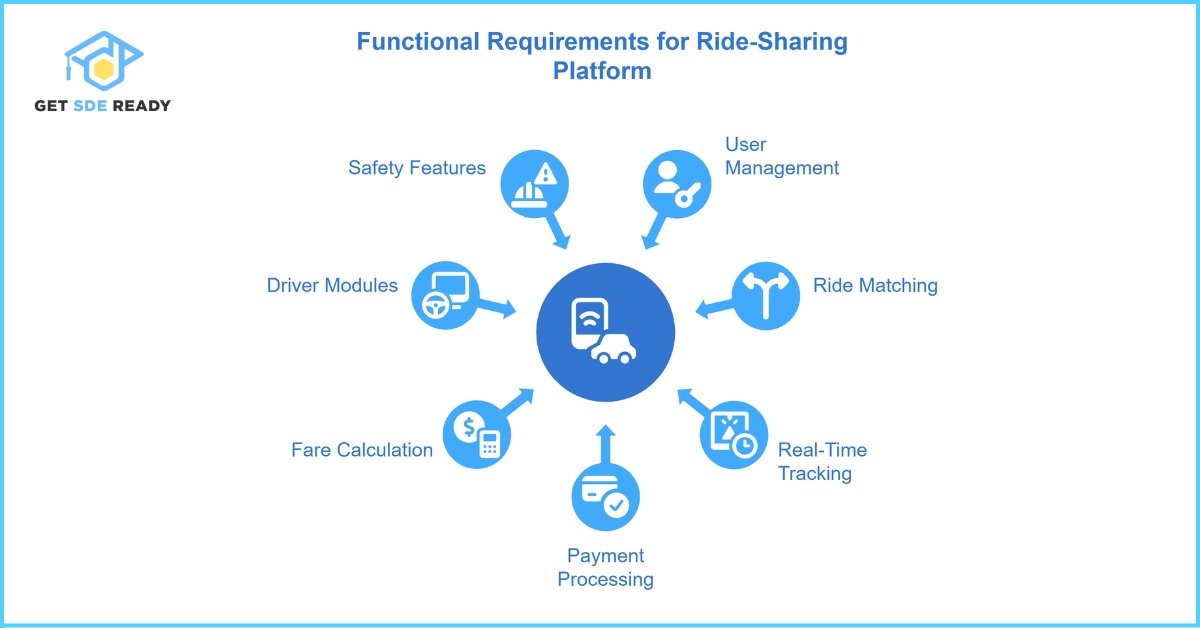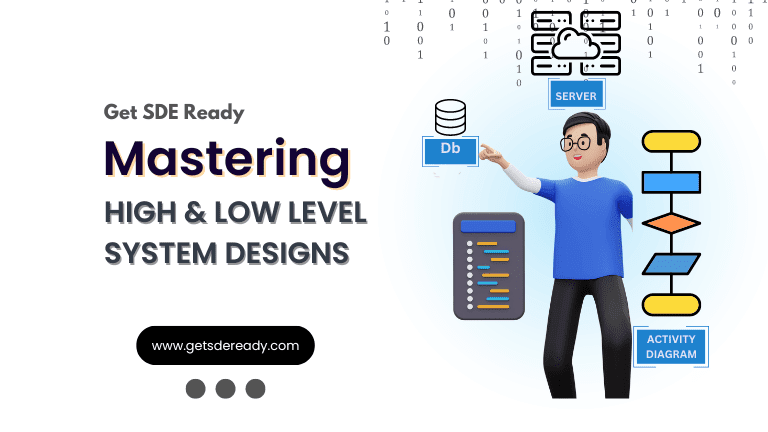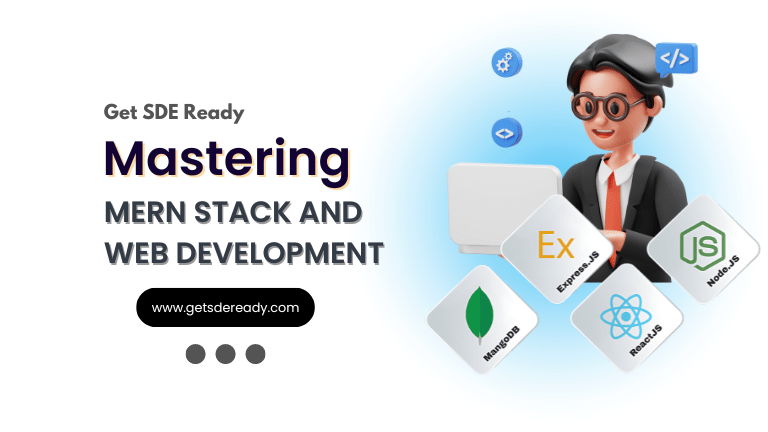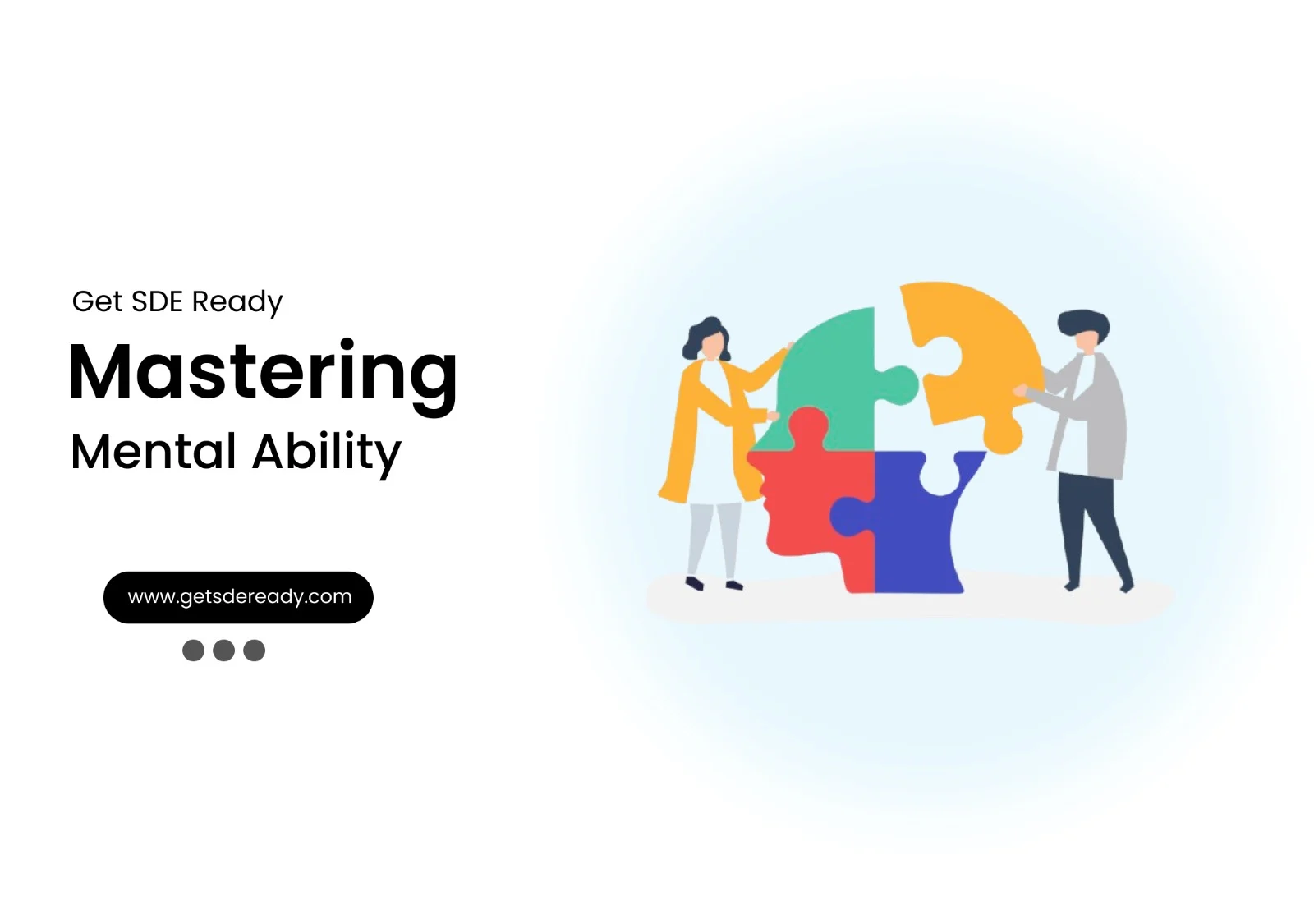Introduction to High-Level System Design
System Design Fundamentals
- Functional vs. Non-Functional Requirements
- Scalability, Availability, and Reliability
- Latency and Throughput Considerations
- Load Balancing Strategies
Architectural Patterns
- Monolithic vs. Microservices Architecture
- Layered Architecture
- Event-Driven Architecture
- Serverless Architecture
- Model-View-Controller (MVC) Pattern
- CQRS (Command Query Responsibility Segregation)
Scaling Strategies
- Vertical Scaling vs. Horizontal Scaling
- Sharding and Partitioning
- Data Replication and Consistency Models
- Load Balancing Strategies
- CDN and Edge Computing
Database Design in HLD
- SQL vs. NoSQL Databases
- CAP Theorem and its Impact on System Design
- Database Indexing and Query Optimization
- Database Sharding and Partitioning
- Replication Strategies
API Design and Communication
Caching Strategies
- Types of Caching
- Cache Invalidation Strategies
- Redis vs. Memcached
- Cache-Aside, Write-Through, and Write-Behind Strategies
Message Queues and Event-Driven Systems
- Kafka vs. RabbitMQ vs. SQS
- Pub-Sub vs. Point-to-Point Messaging
- Handling Asynchronous Workloads
- Eventual Consistency in Distributed Systems
Security in System Design
Observability and Monitoring
- Logging Strategies (ELK Stack, Prometheus, Grafana)
- API Security Best Practices
- Secure Data Storage and Access Control
- DDoS Protection and Rate Limiting
Real-World System Design Case Studies
- Distributed locking (Locking and its Types)
- Memory leaks and Out of memory issues
- HLD of YouTube
- HLD of WhatsApp
System Design Interview Questions
- Adobe System Design Interview Questions
- Top Atlassian System Design Interview Questions
- Top Amazon System Design Interview Questions
- Top Microsoft System Design Interview Questions
- Top Meta (Facebook) System Design Interview Questions
- Top Netflix System Design Interview Questions
- Top Uber System Design Interview Questions
- Top Google System Design Interview Questions
- Top Apple System Design Interview Questions
- Top Airbnb System Design Interview Questions
- Top 10 System Design Interview Questions
- Mobile App System Design Interview Questions
- Top 20 Stripe System Design Interview Questions
- Top Shopify System Design Interview Questions
- Top 20 System Design Interview Questions
- Top Advanced System Design Questions
- Most-Frequented System Design Questions in Big Tech Interviews
- What Interviewers Look for in System Design Questions
- Critical System Design Questions to Crack Any Tech Interview
- Top 20 API Design Questions for System Design Interviews
- Top 10 Steps to Create a System Design Portfolio for Developers
Introduction to High-Level System Design
System Design Fundamentals
- Functional vs. Non-Functional Requirements
- Scalability, Availability, and Reliability
- Latency and Throughput Considerations
- Load Balancing Strategies
Architectural Patterns
- Monolithic vs. Microservices Architecture
- Layered Architecture
- Event-Driven Architecture
- Serverless Architecture
- Model-View-Controller (MVC) Pattern
- CQRS (Command Query Responsibility Segregation)
Scaling Strategies
- Vertical Scaling vs. Horizontal Scaling
- Sharding and Partitioning
- Data Replication and Consistency Models
- Load Balancing Strategies
- CDN and Edge Computing
Database Design in HLD
- SQL vs. NoSQL Databases
- CAP Theorem and its Impact on System Design
- Database Indexing and Query Optimization
- Database Sharding and Partitioning
- Replication Strategies
API Design and Communication
Caching Strategies
- Types of Caching
- Cache Invalidation Strategies
- Redis vs. Memcached
- Cache-Aside, Write-Through, and Write-Behind Strategies
Message Queues and Event-Driven Systems
- Kafka vs. RabbitMQ vs. SQS
- Pub-Sub vs. Point-to-Point Messaging
- Handling Asynchronous Workloads
- Eventual Consistency in Distributed Systems
Security in System Design
Observability and Monitoring
- Logging Strategies (ELK Stack, Prometheus, Grafana)
- API Security Best Practices
- Secure Data Storage and Access Control
- DDoS Protection and Rate Limiting
Real-World System Design Case Studies
- Distributed locking (Locking and its Types)
- Memory leaks and Out of memory issues
- HLD of YouTube
- HLD of WhatsApp
System Design Interview Questions
- Adobe System Design Interview Questions
- Top Atlassian System Design Interview Questions
- Top Amazon System Design Interview Questions
- Top Microsoft System Design Interview Questions
- Top Meta (Facebook) System Design Interview Questions
- Top Netflix System Design Interview Questions
- Top Uber System Design Interview Questions
- Top Google System Design Interview Questions
- Top Apple System Design Interview Questions
- Top Airbnb System Design Interview Questions
- Top 10 System Design Interview Questions
- Mobile App System Design Interview Questions
- Top 20 Stripe System Design Interview Questions
- Top Shopify System Design Interview Questions
- Top 20 System Design Interview Questions
- Top Advanced System Design Questions
- Most-Frequented System Design Questions in Big Tech Interviews
- What Interviewers Look for in System Design Questions
- Critical System Design Questions to Crack Any Tech Interview
- Top 20 API Design Questions for System Design Interviews
- Top 10 Steps to Create a System Design Portfolio for Developers
High Level Design of Uber
What is Uber?
Uber is a ride-hailing platform that connects riders with drivers through a mobile app. It allows users to request rides, get matched with nearby drivers, and pay for trips seamlessly within the app. This scalable ride‑hailing system design relies on real‑time GPS tracking, dynamic pricing algorithms, and automated ride matching to ensure efficiency and reliability. It is built upon advanced data structures and algorithms; to strengthen your foundation in these areas, explore our Data Structures and Algorithms course. For engineers seeking to master algorithmic foundations in distributed systems, our DSA Crash Course provides essential insights into high‑performance application design.
Key Features of Uber
- Ride booking in real time ensuring minimal wait times.
- Real‑time GPS tracking for live driver location updates.
- Seamless payment integration supporting multiple methods.
- Automated ride matching optimizing for shortest pickup ETAs.
To explore advanced optimization techniques in ride‑matching algorithms, review our Top Netflix DSA Interview Questions.
Requirements and Goals
Functional Requirements
- Secure user management enabling registration, login, and profile updates.
- Efficient ride matching using geolocation data to connect riders with drivers.
- Real‑time tracking to display driver position and estimated arrival.
- Robust payment processing with support for refunds and multiple gateways.
- Dynamic fare calculation based on distance, time, and surge pricing.
- Driver onboarding, trip assignment, and earnings tracking modules.
- Safety features including SOS alerts and share‑ride details.
Backend developers can enhance their skill set with our comprehensive Web Development course.

Non‑Functional Requirements
- Low latency under 200 milliseconds for critical ride‑matching APIs.
- High availability with at least 99.99 percent uptime.
- ACID compliance for data consistency in financial transactions.
- Horizontal scaling to support millions of daily active users.
- Efficient storage solutions for terabytes of ride and user data.
Business Goals
- Deliver a seamless user experience to maximize ride completion rates.
- Optimize driver and rider satisfaction through reliable service.
- Reduce operational costs with predictive demand forecasting models.
Capacity Estimations and Constraints
Daily active users: 10 million
Rides per day: 5 million
Peak requests per second: 10,000
Data transfer: 2–5 TB per day from real‑time tracking
Storage: 1 TB of ride data per day; 100 TB of user data over five years
Latency target: < 200 ms for ride matching
Uptime target: 99.99 percent
To master scalable system design and meet these demands, consider enrolling in our Master DSA, Web Dev & System Design course.
System APIs
BookRideAPI
Endpoint: /book-ride
Request parameters: userId, pickupLocation, destination
Response: Ride details with driver info and ETA
TrackRideAPI
Endpoint: /track-ride
Request parameters: rideId
Response: Real‑time driver location and updated ETA
ProcessPaymentAPI
Endpoint: /process-payment
Request parameters: rideId, paymentMethod
Response: Payment confirmation or failure message
RateDriverAPI
Endpoint: /rate-driver
Request parameters: rideId, rating
Response: Confirmation of rating submission
HolidayAPI
Endpoint: /special-days
Request parameters: date, location
Response: Surge pricing details, discounts, and promotions
Database Design and Schema
Tables
- Users: Stores rider and driver profiles.
- Rides: Captures trip details including origin, destination, and timestamps.
- Payments: Logs transaction data and refund statuses.
- Locations: Archives real‑time coordinates for tracking.
Relationships
- One‑to‑many between Users and Rides
- One‑to‑one between Rides and Payments
For best practices in database optimization, review our Data Science course.
Architecture Overview
The platform adopts a microservices architecture divided into:
- User Interface: Mobile apps for riders and drivers.
- Application Layer: Business logic including ride matching and pricing.
- Data Layer: Scalable storage for user, ride, and payment data.
- Third‑Party Integrations: Maps, payment gateways, and notification services.
For a deeper dive into microservices and distributed design, explore our Essential DSA and Web Dev courses.

Deep Dive into Each Component
User Management
Handles authentication and profile updates with OAuth 2.0 and JWT tokens.
Ride Matching
How does Uber match riders with drivers? It uses geospatial indexing and priority queues to minimize wait times and balance supply and demand. Engineers preparing for technical interviews can sharpen their skills with our Top 20 DSA Interview Questions.
Payment Processing
Integrates with Stripe and PayPal and applies ACID‑compliant transactions to ensure consistent financial records.
Real‑Time Tracking
Uses WebSocket connections to stream driver location updates, enabling dynamic map rendering on the rider’s app.
Fare Calculation
Applies dynamic pricing based on real‑time traffic and demand patterns. Machine learning models refine surge pricing thresholds. Data scientists may find our Crash Course in Data Science beneficial for building predictive models.
Safety Features
Includes SOS alerts, share‑ride links, and AI‑based anomaly detection on route deviations to ensure passenger security.
Driver Management
Automates driver onboarding with identity verification, background checks, and digital document processing.
Purging and DB Cleanup
Why purge old data? It prevents bloat, improves query performance, and meets compliance requirements. Uber uses an archival strategy that moves historical rides to cold storage, applies retention policies, and runs automated cleanup jobs. For cleanup patterns and strategies, check our Top Atlassian DSA Interview Questions.
Database Partitioning and Replication
Partitioning Strategies
- Horizontal sharding by user ID or region
- Vertical partitioning to separate hot and cold data
- Time‑based partitioning for older records
Replication Models
- Master‑slave for read scaling and failover
- Multi‑master for global write availability
- Geo‑replication to ensure low latency across regions
System architects can refine their designs with our Master DSA, Web Dev & System Design course.
Cache and Load Balancing
Caching
Uses Redis for read‑through caching of hot ride data and TTL policies to refresh entries.
Load Balancing
Employs round robin and least connections strategies with AWS ELB to distribute traffic and auto‑scale under high load.
To build expertise in performance optimization, explore our Essential DSA and Web Dev courses.

Interview Questions and Answers
How would you ensure data security in Uber’s system?
Use end‑to‑end encryption (SSL/TLS), AES at rest, OAuth 2.0 for authentication, and RBAC for access control. To review related patterns, see our Top Amazon DSA Interview Questions.
How would you handle a system failure during peak hours?
Identify the root cause via monitoring dashboards, switch to backup clusters, notify users, and implement auto‑scaling. Insights on high‑availability design are covered in our Top Meta DSA Interview Questions.
How to predict ETA for rides?
Collect historical trip data, train regression models on distance, traffic, and weather, then update predictions in real time. For ML foundations, see our Data Science course.
How does Uber handle surge pricing?
Surge pricing uses demand forecasting and dynamic adjustment based on real‑time driver availability.
How to optimize routing for drivers?
Integrate with Google Maps APIs and apply graph algorithms such as Dijkstra or A* to compute shortest paths.

DSA, High & Low Level System Designs
- 85+ Live Classes & Recordings
- 24*7 Live Doubt Support
- 400+ DSA Practice Questions
- Comprehensive Notes
- HackerRank Tests & Quizzes
- Topic-wise Quizzes
- Case Studies
- Access to Global Peer Community
Buy for 52% OFF
₹25,000.00 ₹11,999.00
Accelerate your Path to a Product based Career
Boost your career or get hired at top product-based companies by joining our expertly crafted courses. Gain practical skills and real-world knowledge to help you succeed.

SDE 360: Master DSA, System Design, AI & Behavioural
- 100+ Live Classes & Recordings
- 24*7 Live Doubt Support
- 400+ DSA Practice Questions
- Comprehensive Notes
- HackerRank Tests & Quizzes
- Topic-wise Quizzes
- Case Studies
- Access to Global Peer Community
Buy for 50% OFF
₹39,999.00 ₹19,999.00

DSA, High & Low Level System Designs
- 85+ Live Classes & Recordings
- 24*7 Live Doubt Support
- 400+ DSA Practice Questions
- Comprehensive Notes
- HackerRank Tests & Quizzes
- Topic-wise Quizzes
- Case Studies
- Access to Global Peer Community
Buy for 52% OFF
₹25,000.00 ₹11,999.00

Fast-Track to Full Spectrum Software Engineering
- 120+ Live Classes & Recordings
- 24*7 Live Doubt Support
- 400+ DSA Practice Questions
- Comprehensive Notes
- HackerRank Tests & Quizzes
- 12+ live Projects & Deployments
- Case Studies
- Access to Global Peer Community
Buy for 51% OFF
₹35,000.00 ₹16,999.00

Low & High Level System Design
- 20+ Live Classes & Recordings
- 24*7 Live Doubt Support
- Case Studies
- Comprehensive Notes
- HackerRank Tests
- Topic-wise Quizzes
- Access to Global Peer Community
- Interview Prep Material
Buy for 60% OFF
₹20,000.00 ₹7,999.00

Mastering Mern Stack (WEB DEVELOPMENT)
- 65+ Live Classes & Recordings
- 24*7 Live Doubt Support
- 12+ Hands-on Live Projects & Deployments
- Comprehensive Notes & Quizzes
- Real-world Tools & Technologies
- Access to Global Peer Community
- Interview Prep Material
- Placement Assistance
Buy for 53% OFF
₹15,000.00 ₹6,999.00
Reach Out Now
If you have any queries, please fill out this form. We will surely reach out to you.
Contact Email
Reach us at the following email address.
arun@getsdeready.com
Phone Number
You can reach us by phone as well.
+91-97737 28034
Our Location
Rohini, Sector-3, Delhi-110085

